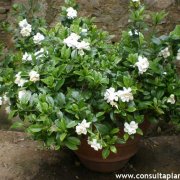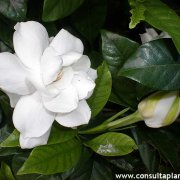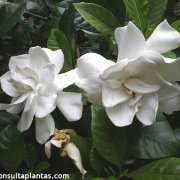Care of the shrub Gardenia jasminoides or Cape Jasmine |
|
The genus Gardenia, family Rubiaceae, includes 130 species of shrubs and trees distributed by subtropical regions of Asia, Africa, Madagascar and some islands of the Pacific Ocean. Some species are: Gardenia jasminoides, Gardenia thunbergia, Gardenia pyriformis, Gardenia tubifera, Gardenia candida. Common names: Cape Jasmine, Common Gardenia, Cape jessamine. This species is native to Asia. They are evergreen shrubs branched from the base that reach 2 meters (6.56 feet) in height (1 meter/3.28 feet in pot). The attractive oblong-lanceolate and opposite leaves are glossy dark green. The showy, scented cream-white flowers are 8 cm (3.14") in diameter and contrast beautifully with the dark foliage. They bloom in summer and early fall. These delicate plants are used as indoor, greenhouse and terrace plants and as single specimens or in small bushy groups. Gardenia jasminoides needs a semi-shade or low light exposure; avoid direct sun in the central hours of the day. The winter temperature should not be less than 12 ºC (53.6 ºF). It does not like the excessive heat of the Mediterranean summer. It's important that the soil is not calcareous. It can be a mixture of well-decomposed manure, commercial substrate for indoor plants and peat in equal parts; add a handful of coarse sand to facilitate drainage. The transplant is done in early spring. Water frequently with lime-free water so that the substrate always remains moist. Common Gardenia does not resist drought and excess water in the roots causes yellowing of the leaves. It needs a high humidity; spray the leaves periodically except in the flowering period. Place a plate with damp pebbles under the pot if it's grown indoors and ventilate frequently (avoid drafts). Fertilize in summer with organic slow-release fertilizer. Prune dry branches after flowering. Cape Jasmine can be attacked by mites and mealybugs if it suffers from drought or low humidity; also by Chlorosis if the substrate is calcareous or irrigated with lime water. Common Gardenia is propagated by cuttings in summer or winter (in this case in glass seedlings) and by air layering. |
Images of the shrub Gardenia jasminoides or Cape Jasmine |
Find plants
Gardenia jasminoides or Cape Jasmine | Care and Growing
© 2026 FavThemes


